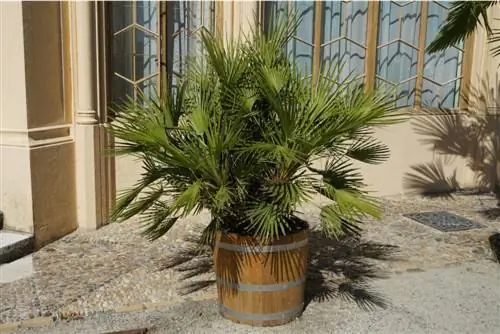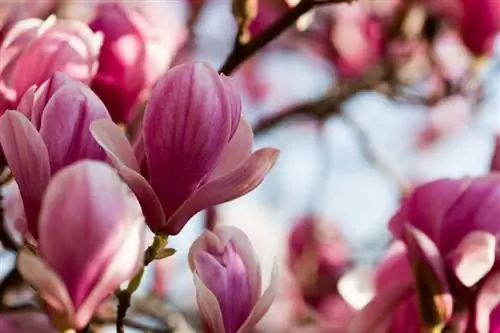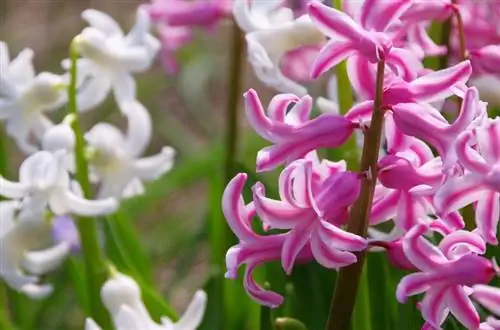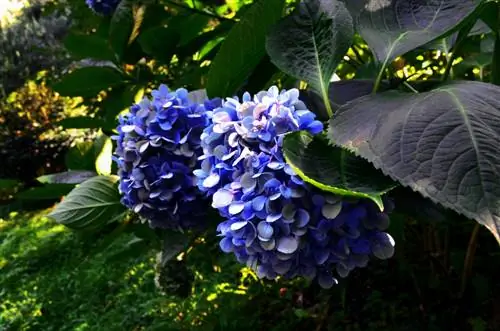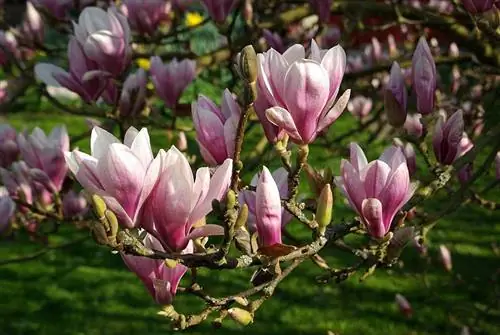- Author admin [email protected].
- Public 2023-12-16 16:46.
- Last modified 2025-01-23 11:22.
Read detailed information about the dwarf palm in the profile here. Is it hardy? Can you plant Chamaerops? Benefit from many tips for planting and care.
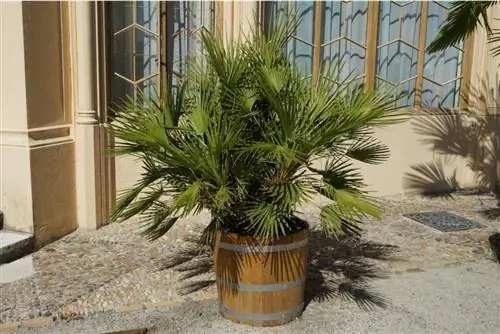
How do I properly care for a dwarf palm tree?
The dwarf palm (Chamaerops humilis) is conditionally hardy and can tolerate temperatures down to -15°C for short periods of time. As a container plant, it prefers coarse-grained, well-drained substrate and a sunny location. For optimal care, water regularly and fertilize during the growth phase.
Profile
- Scientific name: Chamaerops humilis
- Family: Palm family (Arecaceae)
- Origin: Mediterranean region
- Type: Fan Palm
- Growth: multi-stemmed, bushy
- Growth height: 100 cm to 500 cm
- Leaf: stalked, slotted
- Flower: panicle
- Flowering period: April to June
- Toxicity: not poisonous
- Winter hardiness: conditionally hardy
- Use: potted plant
Video: Detailed look at dwarf palms in the Mediterranean region
Winter hardiness
Chamaerops humilis is attested to have a winter hardiness of up to -15° Celsius. It is important to note that frost tolerance is limited to a few days or nights. In fact, frozen ground is very difficult for the roots of a dwarf palm tree. The permanent frost in February 2018 or the harsh winter of 2020/21 with bitter frost and snow even in mild winter regions would have reliably destroyed your planted dwarf palm. In conclusion, it should be noted that dwarf palms are classified as partially hardy and it is better not to plant Chamaerops varieties.
Growth
How big can she get? This is an important question when cultivating a dwarf palm as a container plant. In fact, the German name belies the fact that dwarf palms develop extensive growth in the pot over the years. The following key data must be recorded:
- Multi-stemmed to bushy
- Grow more in width instead of in height
- Growth height in the pot: 100 to 200 cm, rarely higher
- Growth height in the Mediterranean region: 400 to 500 cm
- Growth per year: north of the Alps 5 to 10 cm, on the Mediterranean up to 20 cm
Bloom
Decorative plus point is an early flowering of young Chamaerops humilis from a height of 80 centimeters. From April to June, your dwarf palm boasts bright yellow flower spikes that stand out between the thorny leaf stalks. Pollinated flowers turn into orange berries by fall.
Leaf
Leaves worth seeing are the most beautiful decoration of a dwarf palm. The following properties characterize the palm fronds:
- Leaf shape: semicircular fan
- Diameter: 60 to 70 cm
- Leaf blade: deeply slotted
- Leaf stem: up to 45 cm long, with sharp thorns
- Leaf color: dark green to blue-green, sometimes silvery underneath
The leaves are so firm that the fans keep their shape even on the windy balcony.
Toxicity
The dwarf palm is not poisonous. However, the hard thorns on the petiole should not be underestimated. It is advisable to place the fan palm out of the reach of children. We also recommend wearing thorn-proof gloves when planting and caring for plants.
Excursus
Dream team dwarf palm and dwarf date palm
The Mediterranean holiday feeling on the balcony is perfect when dwarf palms and dwarf date palms appear side by side. The fan leaves of Chamaerops humilis harmonize impressively with the pinnate leaves of a Phoenix roebelenii. Both palm beauties are easy to care for and spend the cold season peacefully in winter quarters.
Planting dwarf palm
In the profile you can read about winter hardiness that you cannot plant a dwarf palm north of the Alps. As a container plant, the distinctive fan palm spreads a Mediterranean flair on balconies and terraces until the first frost. Read the following tips about which soil belongs in the pot, where you should ideally place the dwarf palm and how to propagate it successfully.
Substrate
Chamaerops appreciate a coarse-grained, humus-rich and well-drained substrate with a portion of clay soil and a few handfuls of sand. The best way to prevent fatal waterlogging is to add expanded clay or lava granules. The pH value plays a key role with an ideal value of 5.5 to 6.5. Before you pour the substrate into a deep, wide bucket, please place a few pieces of pottery on the bottom as drainage.
Location
In our latitudes, the dwarf palm becomes a vagrant in the pot. A repeated change of location throughout the year simulates the general conditions in the Mediterranean region. How to do it right:
- Rule of thumb: sunny to bright all year round, warm in summer, cool and frost-free in winter
- Beginning/mid-March to early/mid-April: harden off during the day in partial shade on the balcony or terrace (put away in the evening)
- From May: full sun to partial sun
- End of September/beginning of October: move in front of the house wall
- November/December: clear up from -5° Celsius
In the wintering section, various location options are explained in more detail with tips on suitable winter quarters.
Propagation
The dwarf palm provides you with the perfect starting material for easy propagation. Lateral offshoots grow at the base of the trunk. These children look very similar to their mother plant. When you cut off a cutting, it should have already formed its own roots, which can be recognized by the noticeable resistance to slight pulling. Plant the palm tree in a pot with coconut soil or pricking soil. Moisten the substrate with room temperature, lime-free water. Maintain the offshoot in a warm, bright window seat at an ideal temperature of 20° to 23° Celsius.
Propagation by seeds is more time-consuming. Before sowing, the hard seed coat is roughened with sandpaper and the seeds are soaked in water for 48 hours. Fill the dark germinators with moist coconut soil into a freezer bag or sealable container. Store the seed container at 22° to 27° Celsius. Germination does not require light. It is important to maintain constant moisture in the seed substrate. Now patience is required, because palm seeds only germinate after many weeks and months.
Care for dwarf palm
Changing locations throughout the year result in alternating water requirements. The optimal supply of nutrients is tailored to the season. Successful overwintering depends on the general conditions in the winter quarters. Cutting is even less common on the care program than repotting. You can read how to properly care for a dwarf palm and solve problems skillfully in the following short instructions.
Pouring
Collected rainwater is very suitable for your dwarf palm as irrigation water. Alternatively, you can cover your water requirements with well-stagnant tap water. How to water correctly:
- Watering supplies: Substrate has dried on the surface.
- Watering: penetrating until the saucer fills up.
- Rework: Pour out the coaster after 20 minutes.
How often you water a dwarf palm depends on the season. In the scorching hot summer, check the need for watering early in the morning and in the evening using a finger test. During the cold season, your fan palm needs very little water.
Fertilize
From April to September, add liquid palm fertilizer to the irrigation water. Alternatively, apply a slow-release fertilizer in the form of sticks or granules in April and June. Water before and after with clear water for optimal nutrient absorption.
Wintering
There are various options available for wintering. Temperature and lighting conditions in the winter quarters determine modified care. The following overview gives the details:
- Premium winter quarters: bright (1000 to 1200 lux) and tempered at 10° to 12° Celsius
- Optional locations: winter garden, glazed terrace, staircase, winter tent on the balcony
- Alternative: dim (500 to 800 lux) and cool at 5° to 8° Celsius
- Optional locations: Garage with windows, garden house with frost guard
The rule of thumb for the winter care program is: the darker and cooler the winter quarters, the more economical the watering.
Cutting
The dwarf palm thrives best without pruning. Cutting palm trees is always tricky because the only point of vegetation is at the top of the crown. The only reason for pruning care is a dead leaf. Please be patient until the fan has dried brown. Leave a 3 cm long piece of the leaf stem for an evenly thick trunk.
Repotting
Every few years a dwarf palm has roots through the bucket. If the first roots push out of the soil or peek out of the bottom of the pot, you should repot the fan palm. The best time is in spring, shortly before moving to the balcony. On this occasion, rooted offshoots can be particularly easily cut off for propagation.
Solve problems
The dwarf palm is generally spared from diseases. If problems arise, it is either due to neglect in care or pest infestation. The following table provides an overview of common malfunctions, names the causes and gives tips for countermeasures:
| malicious image | Cause | What to do? |
|---|---|---|
| brown lace | dry air | spray with lime-free water |
| yellow, brown spots | Sunburn | Place in partial shade for 14 days |
| white spots | Scale and mealybugs | Wipe leaves with soap and spirit solution (€12.00 on Amazon) |
| yellow leaves | Waterlogging | repotting |
Popular varieties
Chamaerops humilis is not the only dwarf palm that has won its way into the hearts of hobby gardeners with its Mediterranean charm and ornamental palm fronds, as the following variety selection shows:
- Chamaerops humilis volcano: compact, slow growth, firm fan leaves, very easy to care for.
- Chamaerops compacta: Synonym for the premium variety Volcano.
- Chamaerops humilis cerifera: Blue dwarf palm, silver-blue leaves, also tolerates partial shade.
- Chamaerops excelsa: Synonym for Trachycarpus fortunei (hemp palm), single-stemmed fan palm, petiole without thorns, 4 m to 9 m high.
Extra tip: The bottom of this list of varieties makes it clear how important it is that you pay attention to the exact, scientific name of the dwarf palm tree you want when purchasing.
FAQ
When can a dwarf palm go out on the balcony?
To protect against sunburn, we recommend winterizing in stages. From March or April, a dwarf palm can be taken out onto the balcony during the day to a location in partial shade. Beforehand, check that the temperatures do not fall below freezing point to -5° Celsius. After a two-week acclimatization phase, the dwarf palm takes its regular place in the sunny location.
Can oil be obtained from dwarf palm fruits?
The ripe berries of a dwarf palm contain, among other things, a fatty oil. Compared to the fruits of real oil palms (Elaeis guineensis), the proportion is negligible and the production process is extremely complex. Oil palms produce up to 6,000 berries weighing up to 50 kilograms, making processing into palm oil worthwhile, despite global protests from committed environmental organizations.
How can you soften dwarf palm water with home remedies?
Hobby gardeners swear by a simple home remedy to make hard tap water digestible for a dwarf palm tree. Fill a cotton bag with a liter of peat or bark mulch. Tie the bag closed and hang it in a 10 liter watering can with tap water. Within 24 to 48 hours, hard tap water turns into soft irrigation water.

